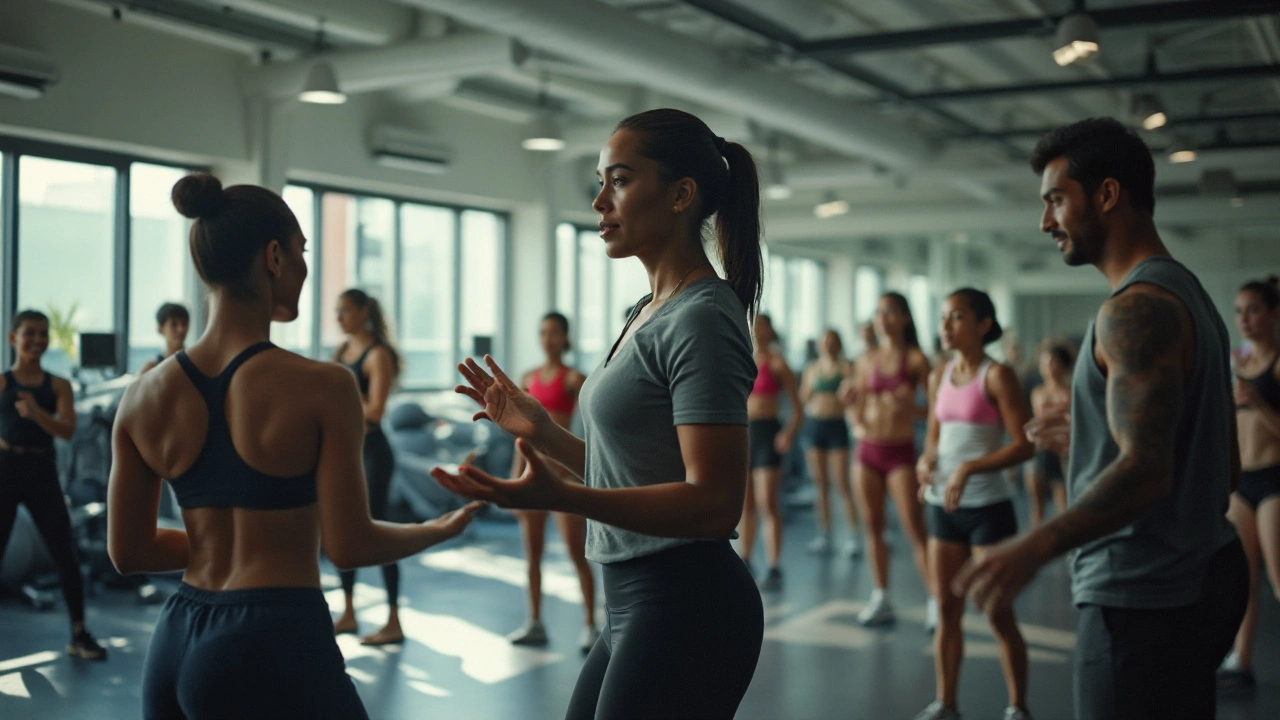Diving into the world of gym workouts can feel overwhelming with countless exercises and routine types to choose from. Knowing where to start and how to structure your sessions can make a significant difference in achieving your fitness goals. Whether you aim to build muscle, lose weight, improve endurance, or enhance overall well-being, a well-thought-out plan is essential.
Many factors come into play when designing your ideal workout routine, including understanding what you want to achieve, which exercises suit your needs, and how to combine them effectively. It's not only about lifting weights or running on the treadmill; it's about creating a balanced approach that caters to your body's requirements while keeping you motivated.
- Understanding Your Fitness Goals
- Strength Training Essentials
- Cardiovascular Workouts for Heart Health
- Balancing Flexibility and Mobility Exercises
- Maintaining Motivation and Avoiding Burnout
Understanding Your Fitness Goals
When it comes to embarking on a journey to fitness, understanding your fitness goals forms the foundation of any effective gym workouts. Your goals will guide you to tailor your workouts in a way that not only keeps you motivated but also ensures that every sweat session brings you a step closer to what you want to achieve. Start by clarifying whether you want to bulk up, slim down, or maybe it’s about boosting your endurance to run that next 10k. The clearer your objectives, the easier it becomes to craft a personalized approach that aligns with your ambitions.
One common first step is setting SMART goals—Specific, Measurable, Achievable, Relevant, and Time-bound. For example, instead of vaguely wanting to ‘get fit,’ you might decide to ‘lose 10 pounds in 3 months by doing strength training three times a week and a cardio session twice a week.’ This precision not only gives you a roadmap but also delivers the satisfaction of ticking off mini-milestones along the way. Keep your aspirations realistic to encourage steady progress, rather than chasing unattainable targets that could sap your motivation.
To further personalize your path, consider consulting with fitness professionals. As the American Council on Exercise suggests, a certified trainer can provide insight into what exercises suit your body type and fitness background, optimizing your workout routines to ensure safety and efficiency. Such input could significantly enhance your progress as a working professional might pinpoint areas requiring attention that you might overlook on your own.
"The right goal-setting approach can be the difference between giving up and forging forward," notes fitness expert Jillian Michaels, emphasizing the importance of crafting goals that drive success through pragmatism and passion.
Tracking progress is another part of understanding what you set out to achieve. Keep a workout journal to monitor consistency and results, or use apps that log your exercise data for easy reflection. Technology has made it easy to analyze patterns and refine your approach. Many apps allow you to record not only your physical progress but incorporate nutritional insights too, providing a holistic view of your lifestyle changes. This process can reveal fluctuations in performance and help identify tactics to overcome plateaus.
Lastly, one must recognize the importance of flexibility in goal-setting. As you dive deeper into your fitness journey, it's entirely normal for your goals to evolve. Perhaps you start with losing weight but discover a passion for gaining strength, flipping the initial focus of your fitness routine. Adapting your goals as you grow not only keeps things fresh but fortifies commitment. Remember, the journey is personal; what works for one might not suit another, hence customizing your journey is key to witnessing long-term benefits. This self-awareness and readiness to recalibrate goals as needed play a crucial role in achieving a sustainable and rewarding fitness regimen.
Strength Training Essentials
When it comes to building a comprehensive gym workouts plan, incorporating strength training is non-negotiable. This form of exercise isn't just about bulking up; it's about improving muscle mass, bone density, and even joint health. Many people often underestimate the importance of strength training, opting instead for purely cardiovascular workouts. While cardio has its place, the benefits of strength training extend far beyond just muscle growth.
One essential aspect to understand about strength training is progressive overload. This is the process of gradually increasing the weight, frequency, or number of repetitions in your strength workouts to challenge your muscles and stimulate growth. It's crucial because the human body is an ingenious mechanism that adapts to the demands placed on it. Without consistently challenging yourself, progress can stagnate. For beginners, a standard recommendation is to start with a couple of days each week focused on major muscle groups — legs, back, chest, and arms.
There are several ways to approach strength training, from traditional free weights to resistance machines, or bodyweight exercises and resistance band workouts. Each method has its pros and cons, depending on accessibility, personal preference, and existing fitness levels. For those who are new to strength training, machines can provide a guided path to ensure proper form, while seasoned lifters might prefer free weights for a fuller range of motion and muscle engagement. A varied routine is often most effective in preventing plateaus and keeping your mind engaged as much as your body.
"The evidence is quite compelling concerning the benefits of strength training," states Dr. Stuart Phillips, a professor in the Department of Kinesiology. "We see significant health benefits across life stages, with lower risks of cardiovascular disease, obesity, and all-cause mortality when strength training is regularly incorporated into one's routine."
An essential element of effective strength training is ensuring you include all major lifts such as squats, deadlifts, bench press, and pull-ups into your regimen. These compound exercises work multiple muscles at once, maximizing your efforts and improving functional strength. Beginners can focus on bodyweight variations, gradually incorporating weights as they build confidence and technique. Alongside the physical adaptation, mental resilience improves as well, empowering individuals to lift more both in and out of the gym.
Let's also discuss a balanced structure for a workout with strength training as its core. A typical routine might involve beginning with three to five sets of a multi-joint lift, like a deadlift, followed by accessory lifts targeting the smaller, stabilizing muscles. These could include bicep curls, tricep extensions, and leg raises. Keep rest periods between sets between 30 to 90 seconds to maintain high energy, and remember to hydrate regularly during sessions. Safety is paramount, so focus on correct form and technique over simply lifting heavier weights. Investing time in mastering proper movement patterns minimizes risk of injury and optimizes time spent in the gym.
To wrap it up, let me share some fascinating numbers. A study published in the Journal of Strength and Conditioning Research found that people who engaged in strength training at least twice a week had a 23% lower risk of premature death. Additionally, strength training can increase your resting metabolic rate, helping you burn calories more efficiently even when not exercising. No wonder this routine is hailed as a critical component of a well-rounded fitness regimen, providing versatile and profound benefits.

Cardiovascular Workouts for Heart Health
Cardiovascular workouts are a vital component of a well-rounded fitness routine, essential for keeping your heart healthy and strong. Whether you're a seasoned athlete or a gym novice, integrating these workouts offers tremendous benefits that extend beyond just weight loss. A strong cardiovascular system helps improve blood flow, increase lung capacity, and decrease your risk of developing various forms of heart disease. To get started, one must understand the different types of cardiovascular exercises and how they work to optimize heart health.
Jogging, cycling, and swimming are classic examples of cardio exercises that you'll likely encounter. Among these, jogging remains one of the most accessible and effective ways to elevate your heart rate. For those who may have joint concerns, cycling offers a low-impact alternative that delivers similar heart-healthy benefits. Swimming engages multiple muscle groups and enhances lung strength, making it one of the most comprehensive cardiovascular workouts. According to the American Heart Association, adults should aim for at least 150 minutes of moderate-intensity aerobic activity a week. This goal might sound daunting, but when broken down, it could mean just 30 minutes a day, five days a week.
High-Intensity Interval Training (HIIT)
One of the more popular and effective methods of cardiovascular exercise is High-Intensity Interval Training, or HIIT. This workout style alternates between periods of intense exertion and short recovery times. HIIT can effectively boost your cardiovascular health and also improve metabolism and burn calories quickly. It’s crucial to listen to your body and start at a pace that feels challenging yet manageable. As noted by fitness experts, just 20 minutes of HIIT performed a few times a week can vastly improve your heart health and overall fitness levels.
"The benefits of aerobic exercises for cardiovascular health are extensive, making them a non-negotiable part of any fitness routine," advised Dr. Leah Benton, a leading cardiologist, in a recent interview.Incorporating aerobics or dance-based exercises can also add variety and enjoyment to your workout routine, preventing boredom and keeping you engaged.
Addition of technology to these workouts has significantly changed the landscape. Heart rate monitors and fitness trackers can provide real-time feedback, helping you maintain the optimal heart rate zone for maximum benefits. Both beginners and seasoned gym-goers can leverage this tech to fine-tune their workouts and ensure physical activity aligns with personal heart rate targets. Remember, consistency trumps intensity. Regardless of the cardio exercise you choose, the key to maintaining improved heart health is engaging in these activities regularly. The achievements in cardiovascular workouts aren't measured by speed or endurance alone—it's about making continuous efforts to remain active and challenging your heart in new and exciting ways.
Balancing Flexibility and Mobility Exercises
When it comes to a comprehensive gym workout, giving attention to flexibility and mobility exercises is just as important as focusing on strength or cardio. Flexibility refers to the ability of your muscles to lengthen, while mobility pertains to the movement of joints within their range. Both are crucial for preventing injuries, improving posture, and enhancing overall performance. A well-balanced routine that incorporates these elements can make workouts more effective and enjoyable. Stretching regularly, for instance, can ease muscle tension and enhance blood circulation, allowing your body to recover more quickly from intense training sessions. Dynamic stretches, like leg swings or arm circles, can serve as a solid warm-up, while static stretching post-workout aids in cooling down muscles.
Mobility exercises contribute to better movement patterns, which help in executing gym workouts more efficiently. Consider integrating movements such as lunges or hip flexor stretches into your routine. These can improve joint function and reduce the risk of wear and tear on your muscles and tendons. According to Dr. John Rusin, a renowned strength coach, ">
"Incorporating regular mobility work can drastically improve your strength potential by preparing your body to move optimally."For many, the benefits of integrating flexibility and mobility exercises also include increased mind-muscle connection, leading to more precise control during lifts or sprints. It's suggested to spend at least 15-20 minutes per session focusing on these exercises to maximize gains. Not only do these elements synergize with more traditional forms of gym workouts, but they also play a role in lifelong physical health.
Trainers often recommend diversifying your repertoire of stretches and drills. Adding a mix of yoga poses, foam rolling, or even tai chi can provide versatile benefits. In creating your strategy, the key lies in understanding your body's unique needs. Different individuals have varying flexibility abilities and joint considerations, which significantly influence the approach. Tracking progress with a simple table or diary can help spotlight areas needing attention. Assessing joint range with straightforward tests, such as reaching toes or overhead arm stretches, can gauge progress, motivating continued effort. Ultimately, integrating flexibility and mobility into your fitness routine lays a solid foundation for longevity in fitness and daily functionality. Sessions that begin with mobility work prime muscles for exertion, reducing the chance of strains.
Strategies to Incorporate Flexibility and Mobility
- Start each session with a 5-minute mobility routine to boost joint function.
- Include static stretches focusing on key muscle groups after exercising.
- Dedicate one workout each week solely for flexibility, like a yoga class.
- Use tools like resistance bands to enhance dynamic stretching routines.
- Record improvements in flexibility and mobility as part of fitness tracking.

Maintaining Motivation and Avoiding Burnout
Staying motivated on your fitness journey can be challenging at times, especially when life gets busy or progress seems slow. It’s easy to lose sight of your goals when the initial excitement wanes. To keep the fire burning, it's crucial to set clear, achievable targets. Begin by defining your fitness goals in a way that is personal and meaningful to you, whether that’s building strength, enhancing endurance, or simply feeling more energetic. Breaking these goals down into smaller milestones can provide a strong sense of achievement along the way, boosting motivation as you celebrate each success.
Incorporating variety into your gym workouts is another excellent strategy to stave off boredom. Experiment with different exercises, workout formats, or even try group classes to spice things up. This not only keeps things interesting but also challenges your body in new ways, which can be beneficial for progress. It's important to remember that each individual finds their own rhythm, so what works for one person might not work for another. Finding your personal groove in the gym can make all the difference.
"The key to maintaining motivation is finding something you love and sticking with it." - Arnold Schwarzenegger
Listening to your body is crucial in preventing burnout. It's okay to take rest days or modify your routine if you're feeling overly fatigued. Overtraining can lead to injuries, so incorporating sufficient rest into your schedule is essential for recovery and continued progress. It's a myth that you have to be at the gym seven days a week to see results. In fact, allowing your body time to recover can enhance performance and lead to greater improvements over time.
It’s also beneficial to document your workout journey. Keeping a journal of your activities, progress, and how you're feeling can help you recognize patterns and make adjustments when needed. Seeing how far you've come over time can be incredibly motivating, reinforcing the effort you’ve put in and encouraging you to stick with it. Having a supportive community, whether in-person or online, can also offer motivation and accountability. Encouragement from others can provide a boost when you need it most, reminding you that you’re not alone in your journey.
Consider the importance of mental well-being in your fitness journey. Mindfulness practices like meditation or yoga can complement your physical workouts by reducing stress and enhancing focus. Taking time to mentally recharge can significantly impact your physical performance in the gym and help maintain a long-term commitment to a healthier lifestyle. Remember, the journey is as important as the destination, so enjoy each step along the way.





